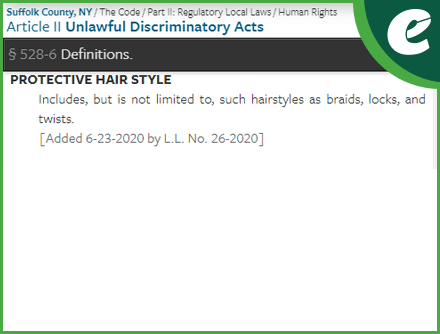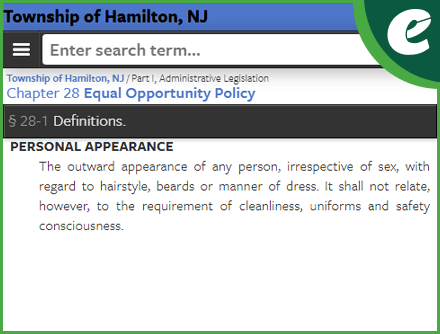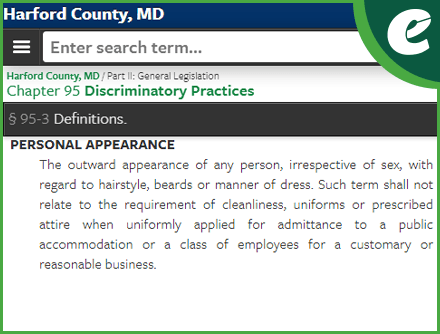Discrimination can come in many shapes and forms, including age, disability, sexual orientation, religion, national origin, race, and more. Banning discrimination through legislation is one powerful way to combat it. Recently, legislative trends have included bans against hair discrimination at both the state and local government levels.
Untangling history
Discrimination against the “natural hair” of Black people finds its roots in the era of slavery in the United States. Many were required to cut their hair short, cover their naturally curly or “kinky” hair with wigs, or wrap it in scarves or handkerchiefs. Their hair was often considered “offensive” or “unacceptable” in its natural state and kept many people of color from rising in cultural and economic status. Special combs and hair straightening products were produced and promoted to Black people as a means of gaining “societal acceptance.” In the later 20th century, some eventually went to court over denials of employment or promotions based on their hairstyles.
The CROWN Act
A recent initiative by the Color of Change organization and the Western Center on Law and Poverty has produced a legislative framework called The CROWN Act to protect citizens (particularly people of color) from discrimination for how they “choose to wear their hair or represent their heritage on the basis of hairstyle choices including Afros, braids, curls, or locs.”
CROWN is an acronym standing for “create a respectful and open world for natural hair.” This initiative has inspired many in government to legislate against hair discrimination in their own states and municipalities.
Legislating against hair discrimination
Many states and local governments are adopting versions of The CROWN Act or updating existing ordinances that already ban discrimination.For many communities it’s an acknowledgement of the diversity of its population. It’s a demonstration of acceptance that natural hair and certain hairstyles are an expression of an individual’s life, personal or family history, culture or religion. And many supporters see it as a way to increase accessibility to employment, economic, and educational opportunities for people of color.
The list of states and local governments enacting this type of legislation or updating their anti-discrimination laws and ordinances continues to grow. Will yours be next?
Useful examples from the eCode360® Library
If your community is interested in legislating or updating existing ordinances ban hair discrimination here are some useful examples that can be found in our eCode360 Library:
Updating your municipal code is vitally important
With the ever-shifting needs of the coronavirus pandemic, local governments continue to adjust and transform their services with digital solutions. Keeping your municipal code updated has become more essential than ever. And providing accessibility to the most current regulations and resolutions is equally important.
We encourage our clients to submit code updates as soon as possible to ensure constituents, local government officials, and municipal staff are always referencing and working with the most up-to-date resources. General Code clients can easily send legislation for quick updates to [email protected].
Best practices for managing your codification budget
Many of our client communities find it helpful to be on a code update schedule. This helps to consistently manage their budgets throughout the year. Our Client Care Advocates can work with you and explain the options and benefits of scheduled code updates. Give them a call at 800.836.8834 or send an email to [email protected]. They’d be happy to help or answer any other codification questions you might have.
Resources:
- A years long push to ban hair discrimination is gaining momentum
- 8 States Across the US That Have Banned Black Hair Discrimination
- How Natural Black Hair at Work Became a Civil Rights Issue
- A History Of Straightening Afro Textured Hair
- A Guide To Hair Discrimination Laws And Their Impact On Employer Grooming Codes In The US
- Discrimination based on hair texture in the United States
- Banning ethnic hairstyles ‘upholds this notion of white supremacy.’ States pass laws to stop natural hair discrimination
- The CROWN Act
- Color of Change
- Western Center on Law and Poverty
- What Is Natural Hair? A Definition and In-Depth Look
- The CROWN Act Makes Waves Across The Country To End Hair Discrimination
- CDC: Types of Discrimination
- St. Louis Mayor Tishaura Jones signs bill banning discrimination based on hair
- Morgantown City Council passes CROWN Act, banning discrimination against natural hair
- Ingham County bans hair discrimination, State Rep. Sarah Anthony discusses MI CROWN Act
- Durham passes ordinance banning discrimination based on hairstyle
- Orange County CROWN Act Expands Non-Discrimination Ordinances to Natural Hair
- Clayton County passes ordinance prohibiting hair discrimination
- CROWN Act: Tucson becomes latest city to pass hair discrimination ban
- Cincinnati outlaws discrimination based on natural hairstyles associated with race
- General Code eCode360 Library





